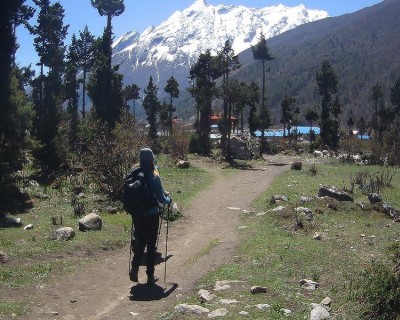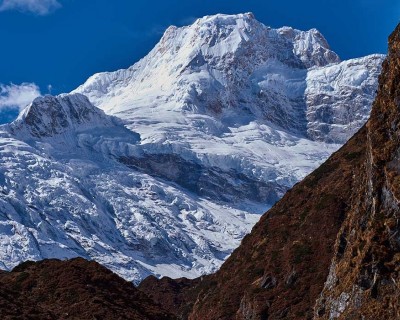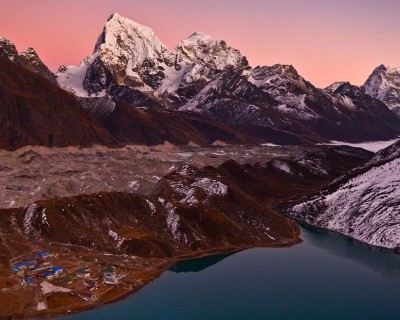At a Glance
- The best time for the Langtang Valley trek is influenced by Nepal’s changes in season
- Spring offers a pleasant experience with moderate temperatures, forest blooms, and bright skies
- Peak trekking season in autumn offers perfect weather and a festive atmosphere
- Solitude seekers can opt for a winter trek despite its extreme cold weather
- Precautions against rain and slippery trails is a must for those willing to take a monsoon trip
- Your goals and preferences define the best time for the Langtang trek
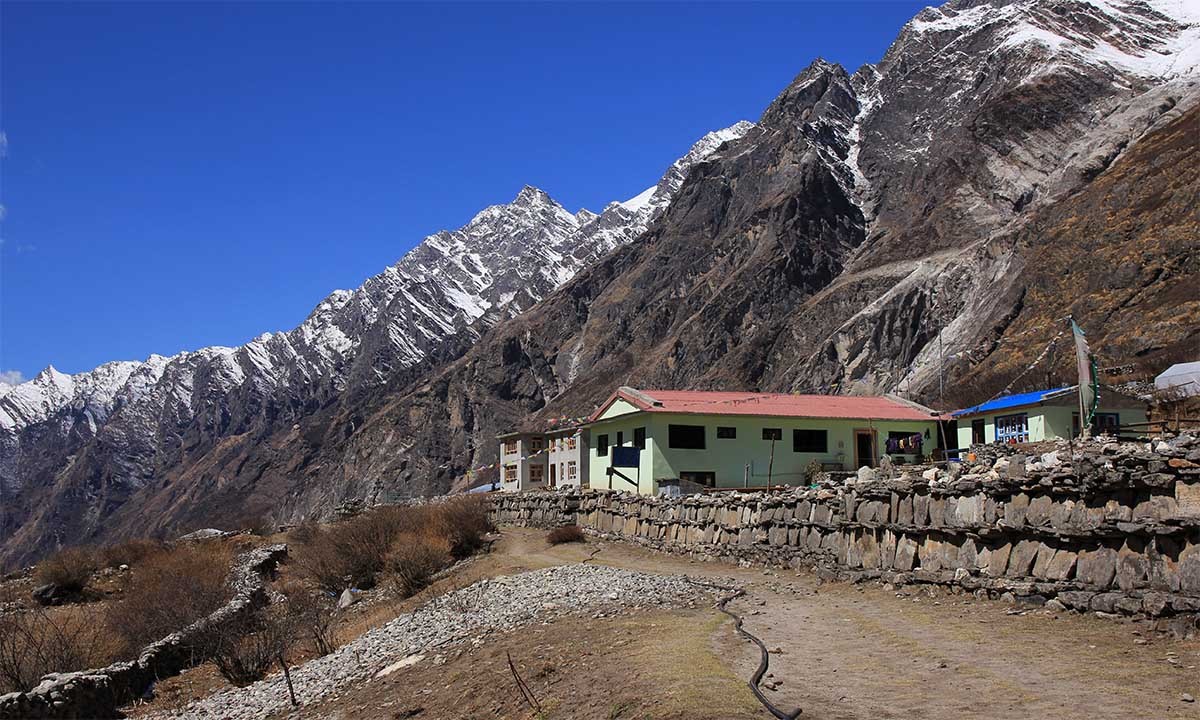
Why Langtang Valley Trek
There is something unforgettable about walking through the alpine beauty of Langtang Valley, thanks to its varied landscape and resources.
Forests with flowers and greenery are an integral part of the trek. Glaciers are other highlights. Langtang Glacier, Yala Glacier and Lantang Lirung Glacier are visible as you reach higher elevations.
Add to that the non-stop presence of towering mountains along your journey. Lantang Lirung, the highest peak in the Langtang range, is the main attraction. No less is the view of its neighboring peak, Lantang Ri.
Trekkers choose to ascend Yala Peak, usually as a side climb. Dorje Lakpa is visible from many points as you tread the trail. You can climb Tserko Ri (4,985m) if you do not want to miss the panoramic views of the region. Gosiakunda Peaks are seen in the distance.
Likewise, local culture and lifestyle add a human touch to your trek. Living and interacting with the Tamang and Sherpa people in their settlements definitely adds value to your trip. You can also explore their cultural heritages, including the Kyanjin Gompa (3,900m).
Add to that the accessibility of the trek trail. You can reach Syabrubesi from Kathmandu via road before starting the trek. No flights are needed. The trek is also moderate. It is a good option even for beginners with a decent level o fitness level.
Nestled in the Langtang National Park, the Valley is just the right choice for ardent trekkers out there.
Understanding the Best Time to Trek to Langtang
The need and preference of the trekker are the major factors in determining the time to explore the Lantang region. However, spring and autumn stand out as the favorable period for trekking not only to Langtang but most areas of Nepal.
They offer an ideal combination of good weather and better trail conditions along with an opportunity for cultural immersion.
Spring: Beautiful Time to Explore Langtang
Spring months: March, April and May
Spring arrives immediately after winter, bringing new vibrancy to the Langtang Valley. The winter cold is gone. The warm and moderate weather rejuvenates the trekking trail, making spring the best time to trek in Langtang Valley.
Spring Features
Pleasant weather: The temperatures range between 10°C–20°C at lower elevations in spring months. Likewise, at higher altitudes, they range from -5°C to 5°C. The mild temperature makes the trek more comfortable and enjoyable.
Longer daylight hours: The daylight hours are longer than in the winter months. This allows you to spend more time on the trail, which automatically helps you meet everyday walking goals with ease.
Great visibility: The overall weather condition is stable. The skies are clear. One can get the best views of rhododendron forests and mountains.
Better trail conditions: The trail en route to Tserko Ri from Syabrubesi is dry and firm during spring. This allows for a comfortable and safe walk for the trekkers. You can expect crowds, yet they are moderate. This is in comparison to the autumn crowds on the route.
Watch Out For
Spring crowds: Due to the favorable weather of spring, the trails are usually crowded with trekkers. Despite the crowd being fewer than that of autumn, the routes are quite busy. So are the teahouses and lodges.
Warmer lower altitudes: Generally, the weather is pleasant, yet you might experience warm daytime temperatures in lower altitudes. So, you can face a problem while trekking in places like Syabrubesi and Bamboo due to the heat. It can be a tiring experience.
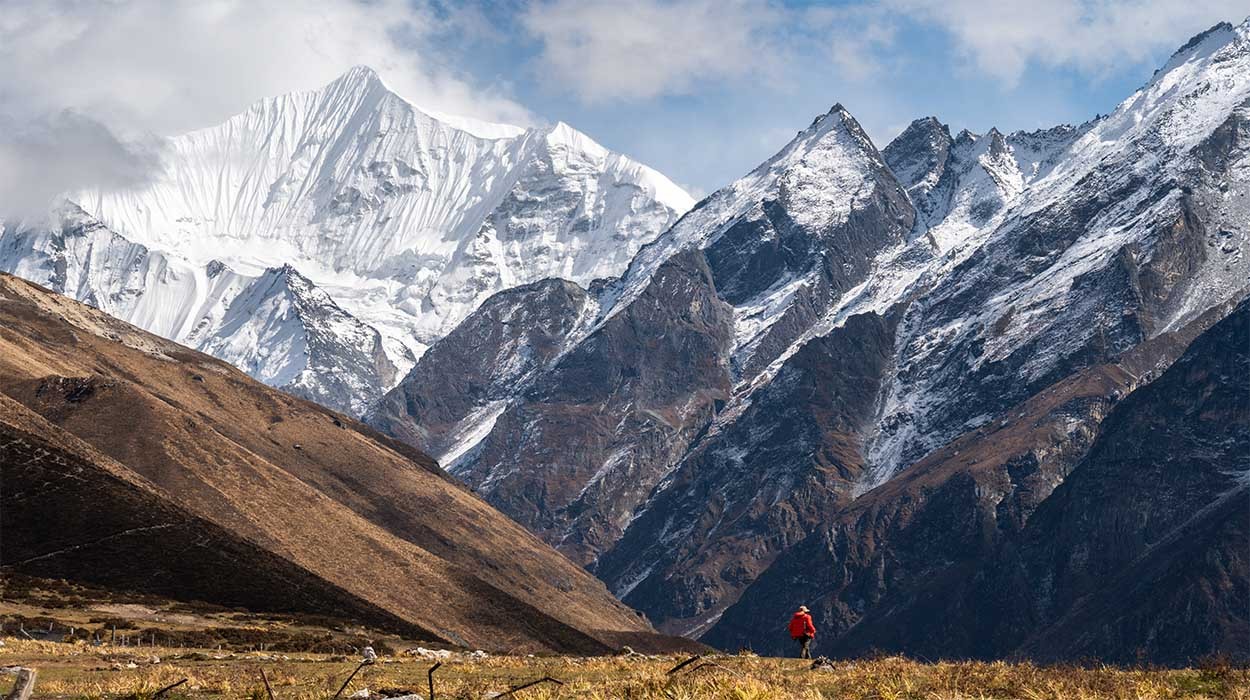
Autumn: Peak Trekking Season
Autumn months: September, October and November
Autumn is the peak season for trekking in Langtang. Thus, it is one of the best times for the Lantang trek. The end of the monsoon heralds autumn in Nepal, offering clarity of the surroundings.
Autumn Features
Ideal trek temperatures: The temperatures in the lower altitudes are between 8°C and 18°C on average in September, October and November. They are fairly moderate and suitable for trekking in the Langtang Valley. The nights, however, are chilly and require you to stay warm.
Best visibility: The post-monsoon season is known for its clear weather in Nepal. The clarity is highest in autumn amongst all four seasons. As such, you are able to get sharp views of the Himalayas along the route. It further allows for a good photo opportunity.
Cultural vibes: Nepal observes festivals like Dashain and Tihar in October and November. So, this time of the year is best for those who are looking for a cultural experience along with trekking. That’s because the villages in Langtang also celebrate these festivals.
Watch Out For
Busy trails: You will witness a good crowd on the trekking trail of Langtang Valley in autumn. It is obvious because of its perfect trekking conditions. So, if you do not want to walk through busy trails, you might want to reconsider trekking during this time.
Higher prices: More people on the trekking trails means higher demand for lodges and teahouses. This leads to an increase in the cost of accommodation and food. Also, there is a high chance of teahouses being packed. To prevent any last-minute issues, you need to pre-book accommodation.
Winter: Quiet Escape in Snow
Winter months: December, January and February
Winter is the off-season for trekking in Nepal. Yet it is possible to trek in Langtang in the winter months. If you are ready to face winter challenges while enjoying the perks of a solitary trek, winter is for you.
Winter Features
Tranquil trail: The number of trekkers is very few on the trail in the winter months. As such, you can enjoy nature without having to face the crowds like that in peak season. The trails are tranquil, offering a peaceful experience for trekkers.
Winter beauty: Trekking to Lantang in winter means being able to soak in its unique natural beauty. Waterfalls are frozen. Landscapes are covered with snow along with the mountain peaks. This makes you feel like you are in a winter wonderland.
Watch Out For
Extreme cold: You need to deal with extreme weather conditions if you want to trek to Langtang in winter. The temperatures go as low as 0 to -10°C. Expect to face snowfall above 3,000m. This can even lead to the blockage of trekking trails in high points. The snow cover also might hide trail landmarks, making you stray from the main route.
Limited services: The teahouses, lodges, and shops along the trekking route may shut down in remote areas. Accommodation facilities that remain open also have limited services. It means you need to be dependent on yourself during the trek. Or you might need the full support of the camping crew to be able to stay and navigate this route.
Shorter days: The days in winter are shorter. This requires you to start early to make sure you arrive at the day’s destination on time. It might be a stressful experience to traverse in the dark.
Monsoon: Off-Season Adventure
Monsoon months: June, July, August
Monsoon trekking in Langtang means you encounter lush and vibrant landscapes. But at the same time, the weather is wet and unpredictable. While most trekkers tend to avoid this season, it is still possible to explore the valley with some caution.
Monsoon Features
Greenery and biodiversity: Monsoon means the greenest time of year in Langtang. You can expect dense vegetation covering hillsides and meadows. Add to that the vibrant activities of wildlife. Red pandas, langurs and different variety of birds can also be seen.
Solitude: It is also the best time of the year to trek in solitude. That is because very few people opt for the Langtang Valley trek in the monsoon. Only those who are well-prepared to face the challenges of the monsoon are there on the trail. Thus, fewer people allow quiet trails.
Watch Out For
Heavy Rainfall and High Humidity: Monsoon mornings and afternoons are known for frequent rainfalls. They tend to be heavy, which makes walking difficult. Cloud cover and mist reduce visibility. Lower altitudes are known for high humidity, making the trekking experience uncomfortable.
Challenging trails: The heavy rainfall raises the likelihood of landslides. Even if there is no landslide, the trail is muddy and slippery. Leeches are common in forested areas. Overall, the train conditions are physically demanding.
Unreliable transportation: As you will be travelling to Syabrubesi from Kathmandu via road, the monsoon rain can delay your travel. The landslides and floods can obstruct the roads, compelling you to cancel or delay your trips.
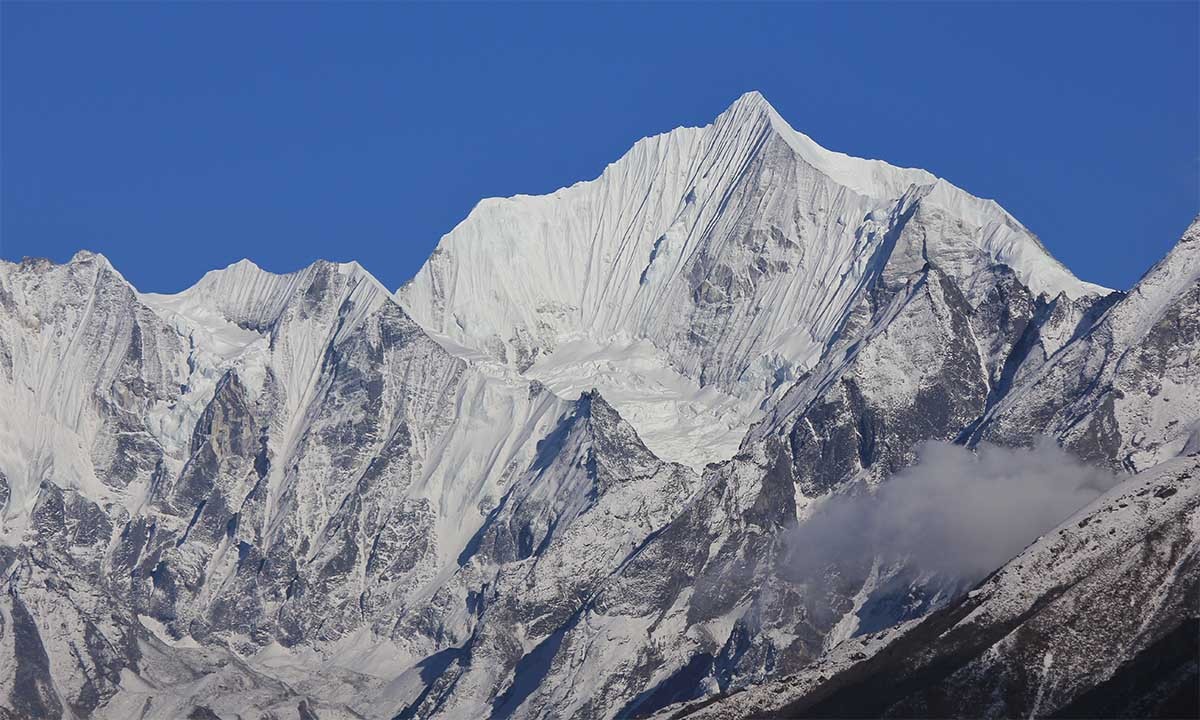
Choosing the Right Time for You
As mentioned before, spring and autumn months are considered the best time for the Langtang Valley trek. Yet the ideal time to go to this region is influenced by several factors. Consider the following aspects to decide what works best for you:
Fitness Level and Experiences
If you are new to trekking with a moderate level of fitness, then the Langtang trek is for you. However, that is true only if you are traversing when the season is favorable for trekking.
The journey in winter and monsoon months is not apt for you as a beginner. As high-altitude trekking is already challenging, the season-specific features add to the difficulties.
You need a very good fitness level if you want to walk through slippery trails and a route covered with snow. Add to that the obstructions caused by frequent rain or snow. So, autumn and spring would be ideal for beginner trekkers.
Tolerance of cold
Cold weather can affect the overall comfort and safety of trekkers. Therefore, if you are thinking of trekking to the Langtang Valley in winter, make sure you can withstand cold temperatures. Otherwise, you might easily suffer from conditions like hypothermia and frostbite.
Likewise, you may be prone to accident risks due to difficulty in gripping and reduced coordination if you have low cold tolerance.
You must invest in cold-weather gear of high quality to mitigate the problems. Yet, if you are uncomfortable with cold weather, winter trekking is not for you.
Trail traffic
Every trekker has their objective when joining an adventure. But if the trail condition do not match their goals, then the journey feels like a waste of time. So, before you set off for the next trek to Lantgang, clearly define your goal.
What do you want? A buzz of trekkers in the teahouses and interaction with fellow trekkers along the route? If you are that social being who can’t be away from vibrant human company, do not plan to trek in winter and monsoon months. Autumn is the best time for the Langtang trek for you. The festivals like Dashain and Tihar add to that vibrancy.
But if you are an introverted person who wants ‘me’ time even on the route, consider trekking in winter or monsoon months. The trails are quieter with very little traffic. You are able to make the most of the journey, enjoying some introspective time.
Photography goals
If one of your major goals of trekking is photography, then spring is the best time for the Langtang Valley trek. This is the beautiful time of the year featuring blooming rhododendrons. They give life and color to the forests of the region.
The mountains are still covered with snow, offering a perfect backdrop for photography.
Also, the days are longer, allowing more time on the trail. You can spend significant time on photography without rushing to reach your destination.
Autumn is also perfect for photography opportunities in the sense that the skies are clear. This allows for the best mountain views.
Accommodations and Services
If comfort and convenience are important for you during the trek, stick to autumn and spring. During this period, the services are running at full capacity. As such, you have easy access to accommodation facilities and other services.
But the teahouses might offer limited services during the off-season months of winter and monsoon. This requires you to compromise with the available services, and it is not a comfortable option for all.
Final Words
If you wish to embark on a trek to Langtang Valley, then consider what matters to you the most. Identify the most suitable time based on your goals and preferences. It is a wise thing to do if you want to fully enjoy your trekking adventure.
Ultimately, keep in mind that what works for one person may not work for you. It is true, especially when determining the best time for the Lantang Valley trek. Select the best fit for your preferences and take the next step for your adventure.
FAQs
Is there the best time for the Lantang Valley trek?
Autumn (September-October) and spring (March-May) are regarded as perfect. But you need to choose your trek timing based on your objective and needs.
Is winter trekking possible in Langtang?
Yes. If you are ready to face the freezing temperatures of winter months and walk on snow-covered trails, opt for a winter trek.
Do monsoon rains affect Langtang trekking trails?
Heavy rains are a feature of monsoon months. You may have to deal with challenges of landslides, muddy and slippery trails and leeches during this time. Proper preparation should be done before undertaking a monsoon trek.
Can I trek to Langtang as a beginner?
You can choose the autumn and spring seasons as a beginner for this trek. But avoid winter and monsoon seasons as the trails and weather conditions are challenging.
What is the best time for the Lantang trek if I want some cultural experiences?
The peak trekking season of autumn coincides with some of the major Nepali festivals like Dashain and Tihar. This is therefore the best time to get a rich cultural experience.
What’s the best time for the Langtang Valley trek for photography?
Spring and autumn offer the clearest views and hued landscapes.





